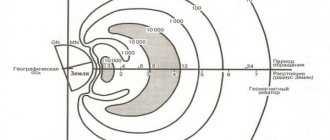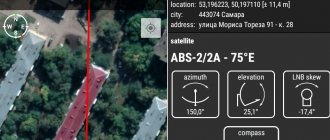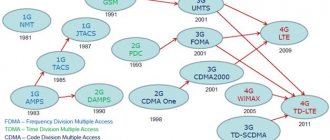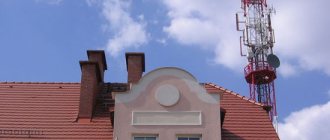Satellite communication is a type of radio communication based on the use of artificial Earth satellites (AES) as repeaters.
In 1957, the first satellite was launched. There were two transmitters on different frequencies, which transmitted the signal “Beep, beep, beep.” It was the first, official, known satellite that overcame the first escape velocity (7,844 m/s at an altitude of 100 km) and entered orbit after making several orbits. It was a ball containing a battery, two transmitters and an antenna.
Then it turned out that with the help of a satellite it is possible to communicate, and communication is practically unlimited in distance within the globe. Low-frequency radio waves do not pass beyond the ionosphere; they are reflected or circle the globe.
When we switch to the VHF range, part of the energy begins to pass through the ionosphere and go into outer space. This limits communication range on the globe, but allows communication with spacecraft, and the spacecraft can communicate with ground stations, which can transmit a signal to it and receive a signal from the satellite. Depending on the communication system, the earth station can be stationary or mobile, which does not limit the use of satellite communications in any way.
Satellites are used as relays. The use of satellites makes it possible to dramatically increase the radio communication range, since the repeater is located high above the Earth, from hundreds to tens of thousands of km.
Communications satellites are that part of humanity's space program from which all people benefit. Gagarin flew into space and this proved that a person can be launched into space and he will return alive and with an unclouded mind. Although, when the second cosmonaut Titov was sent, this is at the level of rumors, he was not all right in the head, Gagarin made one orbit, maybe he didn’t have time to get scared, and Titov did 17 orbits. But now people sit on the space station for a year and everything is fine.
Satellite communications, types, system, equipment, means, orbits, ranges of satellite communications.
Satellite communications is one of the types of space radio communications, based on the use of artificial Earth satellites, usually specialized communications satellites, as relays.
Satellite connection. Space satellite communications. Satellite communication technology
The principle of satellite communication. Satellite communication system, equipment, facilities and stations
Development of satellite communications. History of development in the USSR
Use of satellite communications. Features of the operation of communication satellites
Satellite communications orbits. Orbits of space communication satellites
Satellite communication frequency ranges. Types of satellite communications
How many channels can one communication satellite organize? Satellite communication system
Navigator with SOS button for individual use
based on satellite communications Iridium created a compact tracker Iridium 360° RockSTAR. It weighs about 300 grams and transmits an SOS signal and GPS data from anywhere on the planet.
A message about an emergency situation is received by specialists of the Russian rescue coordination center. In addition, the user’s location can be seen on the Iridium360 portal.
Satellite connection. Space satellite communications. Satellite communication technology:
Satellite communications marks a new stage in the development of advanced technologies, which is inextricably linked with the exploration of outer space.
The definition of satellite communications sounds quite convincing in the following formulation: satellite communications must be equated to a type of space radio communications, which is based on the use of special repeaters - artificial communications satellites.
Satellite communications is one of the types of space radio communications, based on the use of artificial Earth satellites, usually specialized communications satellites, as relays.
The radio signal is relayed by small spacecraft that move around the Earth along a certain trajectory.
The device, launched into orbit in the interests of ensuring relay and processing of radio signals, was called an artificial communications satellite (abbreviated as ISS). Complex relay equipment is mounted on board an artificial communications satellite: signal reception/transmission units, as well as highly directional antennas operating at certain frequencies. The work of an artificial communications satellite consists of receiving a signal, amplifying it, frequency processing and relaying in the direction of earth stations located in the visibility range of the device. A relay satellite is an autonomous device capable of ensuring its location at a given point in space and consuming electricity from on-board power supplies. The stabilization system ensures the specified orientation of the satellite communication antenna . The transmission of data on the position of the spacecraft to Earth and the reception of control commands is provided by telemetry equipment.
Retransmission of the received radio signal can be realized with or without memorization, which is due to the non-constant presence of the satellite in the visibility range of earth stations.
Today, satellite communication systems are an integral part of the world's telecommunication highways, connecting continents and countries.
The principle of satellite communication. Satellite communication system, equipment, facilities and stations:
The principle of satellite space communications involves transmitting/receiving a radio signal using base ground or mobile stations through a satellite repeater. This specificity of ensuring the passage of radio waves is due to the curvature of the earth’s surface, which impedes the passage of the radio signal. In other words, in a line-of-sight zone, a radio signal from one station to another is transmitted without delay. However, if the task is to receive a signal many thousands of kilometers from a transmitting station, then a repeater is required that directs the signal at the appropriate angle to the receiving station.
At its core, satellite communication through a repeater device is a typical analogy of radio relay communication, only in this case, the repeater is located at a considerable distance (altitude) from the earth’s surface, amounting to thousands of kilometers. If organizing radio communications over long distances to different places on the globe required many ground-based repeaters, then with the advent of space satellites their number decreased significantly. Now, only one satellite is required to broadcast a radio signal from one continent to another.
Satellite communications , in general, are provided by a whole complex of interconnected elements of the communication system: relay satellites ; fixed earth satellite communication stations on the earth's surface; satellite communications control center (CSCC) and other elements of the system.
For effective transmission of a radio signal over long distances, an analog signal is not suitable due to its high noise load, so it is first digitized (so-called digital satellite communication ) and then transmitted to a satellite. To correct errors, error-correcting coding schemes are used.
Today, reception/transmission of TV signals and radio broadcasting on the territory of the Russian Federation is provided by satellite communication systems (SCS). Satellite communications are a key element of the interconnected communication network of the Russian Federation. The satellite communication system includes two basic components - ground and space.
Development of satellite communications. History of development in the USSR:
The first artificial Earth satellite was launched into orbit in 1957. The weight of the spacecraft was only 83.6 kg. The satellite was controlled through a miniature unit - a radio transmitter-beacon. The successful results of receiving/transmitting radio signals in outer space made it possible to implement far-sighted plans involving the use of ISS as an active and passive radio signal repeater. However, in order to implement such promising plans, it was necessary to create spacecraft that could carry sufficient weight (a variety of receiving and transmitting equipment). In addition, to launch an artificial satellite into orbit, powerful rocket engines and equipment were needed. After Russian engineers solved these problems, it became possible to launch ISS into outer space to conduct scientific and research work, solve navigation, meteorological, reconnaissance problems, as well as to provide a stable communication channel for transmitting radio signals over long distances. The process of forming a satellite communication system (SCS) intensified after the launch of the first artificial satellite. As part of the implementation of this concept, base transceiver stations equipped with parabolic antennas began to be built on the earth's surface. The antenna diameter reached 12 meters, which made it possible to ensure stable reception and transmission of radio signals. In 1965, Russian engineers managed to ensure the receipt of television programs in Vladivostok, broadcast from Moscow via SSS.
In 1967, after testing and bringing the technical capacity to the required parameters, the Orbita satellite communication system was put into operation. In 1975, the Raduga space satellite was launched into a circular orbit. The distance from the earth's surface to the artificial aircraft was almost 36 km. The direction of rotation of the planet and the satellite practically coincided, so the ISS literally “hovered” above the Earth, remaining motionless throughout the day. This technical solution simplified the transmission of control commands to the spacecraft and guaranteed the functioning of a stable channel for receiving/transmitting radio waves. Subsequently, a more advanced ISS “Horizon” was launched into orbit.
The results of the operation of the Orbita ISS showed the ineffectiveness of servicing the radio signal in the interests of broadcasting television programs in small settlements numbering several tens of thousands of local residents. Therefore, priority was given to compact ground-based signal reception and transmission stations served by the Ekran SSS. The artificial satellite of this satellite communication system was launched into low-Earth orbit in 1976. Now people could watch central television programs even in remote places in Siberia and the Far East.
In the 80s of the last century, the Moscow satellite communication system was actively operated through the Horizon ISS.
Use of satellite communications. Features of the operation of communication satellites:
In the initial period of exploration of near-Earth space, in the interests of relaying radio signals into space, simple satellites were launched containing a minimum of equipment on board (space satellites “ECHO” and “ECHO-2”). A metal sphere of the body, which has a reflective effect, was used as a repeater. Often a metal-coated polymer sphere was used as a reflector. The efficiency of such devices was extremely low, so passive artificial satellites did not receive proper development. Their complete opposite is the active artificial satellites, which have a complex electronic filling inside them, designed to receive, process, amplify and transmit a radio signal to any point on the globe.
According to the method of radio signal processing, space satellites are classified into two types: regenerative and non-regenerative satellites.
Regenerative communication satellites carry out a more extensive set of operations - at the stage of signal reception they demodulate it, and at the time of retransmission they modulate it. This method of radio signal processing requires additional equipment and is quite complex. Regenerative satellites are expensive.
Non-regenerative communications satellites provide the simplest set of operations with radio signals. At the moment of receiving a signal from an earth station, an artificial communication satellite ensures its amplification and transfer to another frequency. Subsequently, the radio signal is relayed to another earth station. A satellite can simultaneously receive and transmit multiple radio signals through different channels (transponders). Each channel is allocated a dedicated part of the spectrum. The disadvantage of this method is the noticeable delay of the relayed radio signal due to the double error correction rules.
Operators
- ACeS covers Asia with a single satellite.
- Inmarsat is the oldest operator (1979). Equips yachts and ships. With 11 aircraft, the company is slowly expanding into the mobile market with the help of ACeS.
- Thuraya serves Asia, Australia, Europe, Africa, Middle East.
- MSAT/SkyTerra is an American provider using equipment equivalent to Inmarsat.
- Terrestar covers North America.
- IDO Global Communications is in the dormant stage.
Satellite communications orbits. Orbits of space communication satellites:
At the moment, there is the following classification of satellite repeater orbits.
Equatorial satellite communications orbit. A characteristic feature of the equatorial orbit is the geostationary approach, which is the basis of the proposed technology. The essence of the approach is that the angular velocity of the relay satellite and the Earth not only coincides, but also moves in the same direction. In other words, the direction of motion of the satellite and the rotation of our planet are identical. The main advantage of the equatorial orbit is that the earth's receiver is constantly in contact with the satellite. In this case, the satellite seems to be in one place, so the radio waves do not encounter obstacles.
The disadvantages of the proposed communication satellite circulation option include the following:
– since hundreds and thousands of different satellites are simultaneously launched into orbit, the risk of them colliding with each other increases, so their trajectories have to be carefully calculated and controlled;
– the high altitude (about 36 thousand km) for launching satellites into orbit leads to significant delays in the transmission of useful information (radio signal delay effect);
– a significant altitude for launching satellites into orbit requires significant material costs;
– impossibility of servicing earth stations in the polar regions.
An inclined satellite communications orbit is a more complex version of movement in outer space and interaction of a satellite with earth stations.
As part of the proposed scheme, earth stations are equipped with special tracking devices that facilitate the search for a space repeater in low-Earth orbit and provide correction of the antenna mirror rotation angle. An important advantage of this approach is the option of constant satellite tracking. In other words, the earth station constantly monitors the location of the satellite and “guides” it across the sky. The innovation fully justifies itself in pre-emergency and force majeure situations, when satellite owners, for various reasons, do not control their location.
The polar orbit of satellite communications is identified with a special case of an inclined orbit and assumes an inclination to the equatorial plane of 90°.
Networks
Commercial projects are limited.
GlobalStar
GlobalStar is a joint brainchild of Qualcomm and Loral Corporation, later supported by Alcatel, Vodafone, Hyundai, AirTouch, Deutsche Aerospace. The launch of 12 satellites was disrupted; the first call took place on November 1, 1998. The initial cost (February 2000) was $1.79/min. Having undergone a series of bankruptcies and transformations, the company provides customers in 120 countries.
Provides 50% of US traffic (over 10,000 calls). Operation is supported by ground repeaters. There are 40 in total, including 7 that accommodate North America. Territories without terrestrial repeaters form a zone of silence (South Asia, Africa). Although the devices regularly plow the heavenly heights.
Subscribers receive American telephone numbers, excluding Brazil, where they are assigned the code +8818.
List of services:
- Voice calls.
- Positioning systems with an error of 30 km.
- 9.6 kbit/s packet Internet access.
- Mobile communication CSD GSM.
- SMS.
- Roaming
The phones use Qualcomm CDMA technology, excluding Ericsson and Telit, which accept traditional SIM cards. Base stations are forced to support both standards.
Iridium
The provider uses a polar orbit, providing 100% coverage of the planet. The organizers went bankrupt, the company was revived in 2001.
This is interesting! Iridium is the culprit behind night sky flares. Flying satellites are clearly visible to the naked eye.
The company's fleet includes 66 satellites using 6 low-orbit trajectories at an altitude of 780 km. The devices communicate using the Ka-band. The lion's share was launched by former bankrupts. As of January 2021, 7 units have been updated. Regeneration continues: the first group (10 pieces) flew away on January 14, the second on June 25, the third on October 9.
This is interesting! The Iridium 33 satellite rammed the Russian Kosmos 2251 on February 10, 2009. Celestial debris is flying over Siberia today.
The company continues to provide services to 850 thousand subscribers. 23% of profits were paid by the state. The cost of a call is 0.75 – 1.5 dollars/min. Callbacks are relatively expensive at $4/min (Google Voice). Typical areas of activity of employers:
- Oil production.
- Marine fleet.
- Aviation.
- Travelers.
- Scientists.
The inhabitants of the Amundsen-Scott South Pole Station asked to convey special gratitude. The company everywhere sells call packages lasting 50-5000 minutes. The validity of the first ones leaves much to be desired, the expensive ones (5000 minutes = 4000 dollars) remain operational for 2 years. Monthly renewal – $45:
- 75 minutes cost $175, use period is 1 month.
- 500 minutes – 600-700 dollars, period of use – 1 year.
Phones
Former owners supplied customers with telephone sets from two manufacturers:
Motorola 9500 became an associate of the company's first commercial trial. The mobile shockproof version 9575, which is still in use today, was born in 2011, supplemented with a GSM emergency call button and an advanced location determination interface. The device sets up a Wi-Fi hotspot, allowing users of ordinary smartphones to send emails, SMS, and surf the Internet.
Kyocera equipment has been abandoned by the manufacturer. Models are sold by resellers. KI-G100, based on a GSM phone with a frequency of 900 MHz, is equipped with a suitcase equipped with a powerful antenna that picks up broadcasts. The ability to receive SMS is ensured; only certain models (9522) can send messages. The SS-66K is equipped with an atypical ball antenna.
- 9575 is a shockproof, waterproof phone equipped with a dustproof case. Withstands temperatures from minus 20 to plus 50 degrees Celsius.
- 9555 – equipped with a built-in headset, a USB interface, and an adapter for an RS-232 serial port.
- 9505A is a hefty brick-shaped gadget. Equipped with a native RS-232 interface.
- SS-55K released in limited edition. Incredible size, sold by eBay resellers.
The company's other equipment included:
- Pagers.
- Payphones.
- Equipment for yachts and aircraft.
Satellite communication frequency ranges. Types of satellite communications:
Earth stations transmit a radio signal to a satellite within a certain range. The specificity of this process is due to the fact that the frequency range for transmitting a radio signal from an earth station differs from the frequency spectrum of the signal relayed from the satellite. In other words, one frequency range is used for transmitting a radio signal, and another for retransmission. This feature is explained by the fact that the layers of the atmosphere transmit the radio signal differently, activating the process of attenuation and absorption of the signal. The frequency ranges of satellite communications are determined by the “Radio Regulations”, taking into account the specificity of the “transparency windows for radio waves” of the atmosphere, the level of radio interference and the influence of other factors.
Frequency ranges used in satellite communications are designated by special letters.
For the L-band, a frequency band of 1.5-1.6 GHz is allocated, the scope of application is mobile satellite communications (MSC).
For the S-band, a frequency band of 1.9-2.2 and 2.4-2.5 GHz is allocated, the area of use is mobile satellite communications (MSC).
For the C-band, a frequency band of 4-6 GHz is allocated, the scope of application is fixed satellite communications (FSS).
For the Ku-band, a frequency band of 11, 12, 14 GHz is allocated, the scope of application is fixed satellite communications (FSS), satellite broadcasting .
For the K-band, a frequency band of 20 GHz is allocated, the scope of application is fixed satellite communications (FSS), satellite broadcasting .
For the Ka-band, a frequency band of 30 GHz is allocated, the scope of application is fixed satellite communications (FSS), mobile satellite communications (MSC), communications between satellites .
For the ENF range, a frequency band of 40-50 GHz is allocated, the scope of application is fixed satellite communications (FSS), the future.
The C-band provides higher quality radio signal reception, but this requires an antenna with a larger dish diameter.
Signal part
The width of the line
The bandwidth of a satellite channel characterizes the amount of information it can transmit per unit of time. A typical satellite transceiver has a bandwidth of 36 MHz at frequencies between 4 MHz and 6 MHz.
Usually the bandwidth of the satellite channel is large. For example, one color television channel occupies a 6 MHz band. Each transceiver on modern communications satellites supports 36 MHz of bandwidth, with the satellite carrying 12 or 24 transceivers, resulting in 432 MHz or 864 MHz, respectively.
Frequency spectrum
Communication satellites must convert the frequency of signals received from the earth station before relaying them to the earth station, therefore the frequency spectrum of a communication satellite is expressed in pairs. Of the two frequencies in each pair, the lower one is used for transmission from the satellite to the ES (downstreams), the upper one is used for transmission from the ES to the satellite (upstreams). Each pair of frequencies is called a band.
Modern satellite channels most often use one of two bands: the C-band (from the satellite to the ES in the 6 GHz region and back in the 4 GHz region), or the Ku-band (14 GHz and 12 GHz, respectively). Each frequency band has its own characteristics aimed at different communication tasks (Table 1).
| Satellite transmission bands, L (GHz) | Band, C (MHz) | Frequency range, Ku (GHz) | Available width, Ka (Hz) |
| 1.6/1.5 | 15 | 6/4 | 500 |
| 14/12 | 500 | 30/120 | 2500 |
Table 1.
Most operational satellites use the C-band. C-band transmission can cover a large area of the earth's surface, making satellites particularly suitable for broadcast signals. On the other hand, C-band signals are relatively weak and require developed and quite expensive antennas on the station. An important feature of C-band signals is their resistance to atmospheric noise. The earth's atmosphere is almost transparent to signals in the 4/6 GHz range. Unfortunately, this is also why C-band signals are best suited for terrestrial point-to-point microwave transmissions, which spoil weaker satellite signals. This circumstance makes it necessary to locate ES that use the C-band for transmission many kilometers from urban centers and densely populated areas.
Ku-band transmission has the opposite properties. The beam of this type of transmission is strong and narrow, making transmission ideal for point-to-point or point-to-multipoint connections. Terrestrial microwave signals do not interfere with Ku-band signals in any way, and Ku-band terrestrial stations can be located in city centers. The natural high power of Ku-band signals makes it possible to get by with smaller, cheaper terrestrial antennas. Unfortunately, Ku-band signals are extremely sensitive to atmospheric conditions, especially fog and heavy rain. Although such weather events are known to affect a small area for a short time, the results can be quite severe if such conditions coincide with the BHH (busy hour, eg 4 pm, Friday afternoon).
Voice and data transmission
Frequency division multiplexing (FDM) is widely used to multiplex multiple voice or data channels onto a single satellite transceiver.
In FDM, the waveform of each individual telephone signal is filtered to limit the bandwidth to the audio frequency range between 300 and 3400 Hz, then converted. The twelve channel signals are then multiplexed into a composite baseband signal. Each group is composed of telephone signals placed in intervals with a bandwidth of 4 kHz. The multiple groups are then re-multiplexed to form a larger group that can contain anywhere from 12 to 3600 individual voice channels.
Time division multiplexing (TDM) is another method for transmitting voice and/or data over a single channel. While in FDM, individual frequency segments within an entire band are assigned to transmit speech (or data), in TDM, transmission is carried out over the entire allocated frequency band. In an outgoing channel, repeatable base time periods, sometimes called frames, are divided into a fixed number of clock cycles, which are allocated sequentially to signal the incoming voice and data channels. To protect against possible loss of information, storage devices (buffers) are used.
Aloha system
The influence of the Aloha multiple access protocol (also known as the Aloha system) developed at the University of Hawaii in the early 1970s on the development of satellite and local communication networks cannot be overestimated.
In this system, satellites use packet transmission over a common satellite channel. At any given time, each AP can transmit only one packet. Since the satellite plays the role of a relay in relation to the packets, whenever a packet from one ES reaches the satellite while it is broadcasting a packet from some other ES, both transmissions overlap (interfere) and “destroy” each other. A conflict situation arises that requires resolution.
Under an early version of the Aloha system, known as the "pure Aloha system", APs can begin transmitting at any time. If, after some time of distribution, they listen to their successful transmission, they conclude that they have avoided a conflict situation (i.e., thereby receiving a positive receipt). Otherwise, they know that an interference has occurred (or perhaps some other noise source was at work) and they must retransmit (i.e., they receive a negative receipt). If the APs immediately repeat their broadcasts after listening, they will most likely find themselves in a conflict situation again. Some kind of collision resolution procedure is required to introduce random delays in retransmission and space out conflicting packets.
Another version of the Aloha system consists of dividing time into segments - windows, the length of which is equal to the length of one packet during transmission (assuming that all packets have the same length). If we now require that the transmission of packets begin only at the beginning of the window (time is tied to the satellite), then we will get a double gain in the efficiency of using the satellite channel, because overlays are limited to the length of one window (instead of two, as in the pure Aloha system). This system is called the Aloha synchronous system (Figure 2).
Figure 2.
Vulnerability period for the Aloha system.
The third approach is based on reserving time windows at the request of the AP.
Readers familiar with LAN multiple access protocols will recognize that the Aloha system described here is the predecessor to the Carrier Sense Multiple Access with Collision Detection (CSMA-CD) protocol used in Ethernet networks. A special feature of the CDMA-CD protocol is the ability to quickly detect conflicts (within micro- and even nanoseconds) and instantly stop transmission. On satellite channels, due to the long propagation time, promptly stopping the transmission of obviously damaged packets is, unfortunately, impossible.
Another improvement of the Aloha system can be the assignment of priorities for stations with high load intensity.
Ground segment
Technological development has led to a significant reduction in the size of the ES. At the initial stage, the satellite did not exceed several hundred kilograms, and the satellites were giant structures with antennas more than 30 m in diameter. Modern satellites weigh several tons, and antennas, often no more than 1 m in diameter, can be installed in a wide variety of locations. The trend of reducing the size of the equipment, together with simplifying the installation of equipment, leads to a reduction in its cost. Today, the cost of ES is perhaps the main characteristic that determines the widespread use of SSS. The advantage of satellite communications is based on serving geographically distant users without the additional costs of intermediate storage and switching. Any factors that reduce the cost of installing a new AP will definitely contribute to the development of applications focused on the use of SSS. The relatively high costs of deploying terrestrial networks allow terrestrial fiber-optic networks to successfully compete with SSNs in some cases.
Consequently, the main advantage of satellite systems is the ability to create communication networks that provide new communication services or expand existing ones, while from an economic point of view, the advantage of satellite systems is inversely proportional to the cost of the satellite.
Depending on the type, the station has transmission and/or reception capabilities. As already noted, virtually all intelligent functions in satellite networks are carried out in the satellite station. Among them are the organization of access to satellite and terrestrial networks, multiplexing, modulation, signal processing and frequency conversion. Finally, we note that most problems in satellite transmission are solved by satellite equipment.
Currently, there are four types of ES. The most complex and expensive are those with very high throughput oriented toward high user loads. Stations of this type are designed to serve user populations that require fiber-optic communication lines to ensure normal access to the AP. Such APs cost millions of dollars.
Medium-capacity stations are effective for servicing private corporate networks. The sizes of such ES networks can be very diverse depending on the implemented applications (speech, video, data transmission). There are two types of corporate CCC.
A mature, capital-intensive enterprise network typically supports services such as video conferencing, email, video, voice, and data. All stations of such a network have equally high throughput, and the cost of a station reaches up to $1 million.
A less expensive type of corporate network is a network of a large number (up to several thousand) of microterminals (VSAT - Very Small Aperture Terminal) connected to one main earth station (MES - Master Earth Station). These networks are usually limited to receiving/transmitting data and receiving audio-video services in digital form. Microterminals communicate with each other through transit with processing through the main terminal. The topology of such networks is star-shaped.
The fourth type of station is limited by reception capabilities. This is the cheapest station option, since its equipment is optimized to provide one or more specific services. This ES can be oriented towards receiving data, audio, video or combinations thereof. The topology is also star-shaped.











